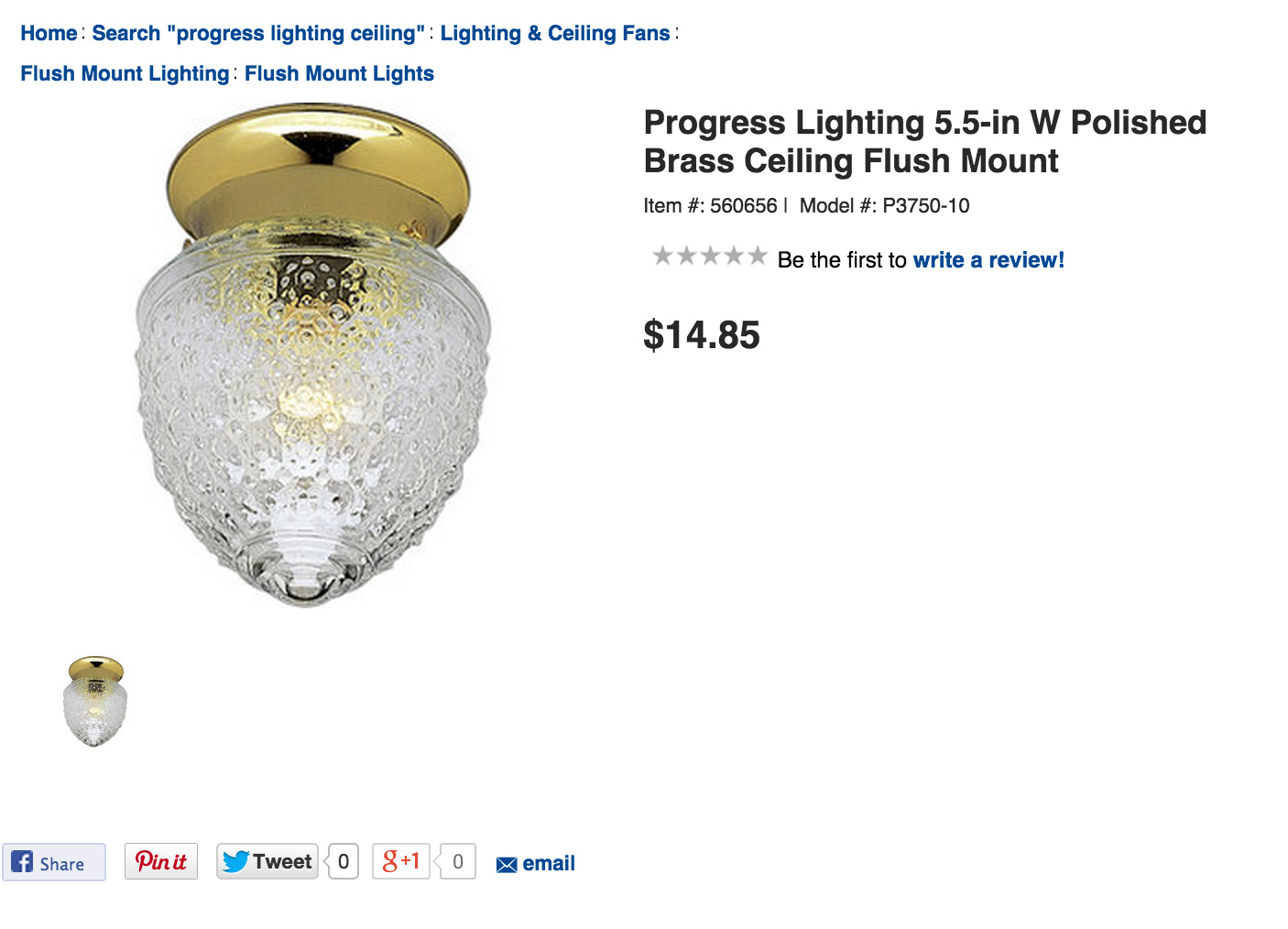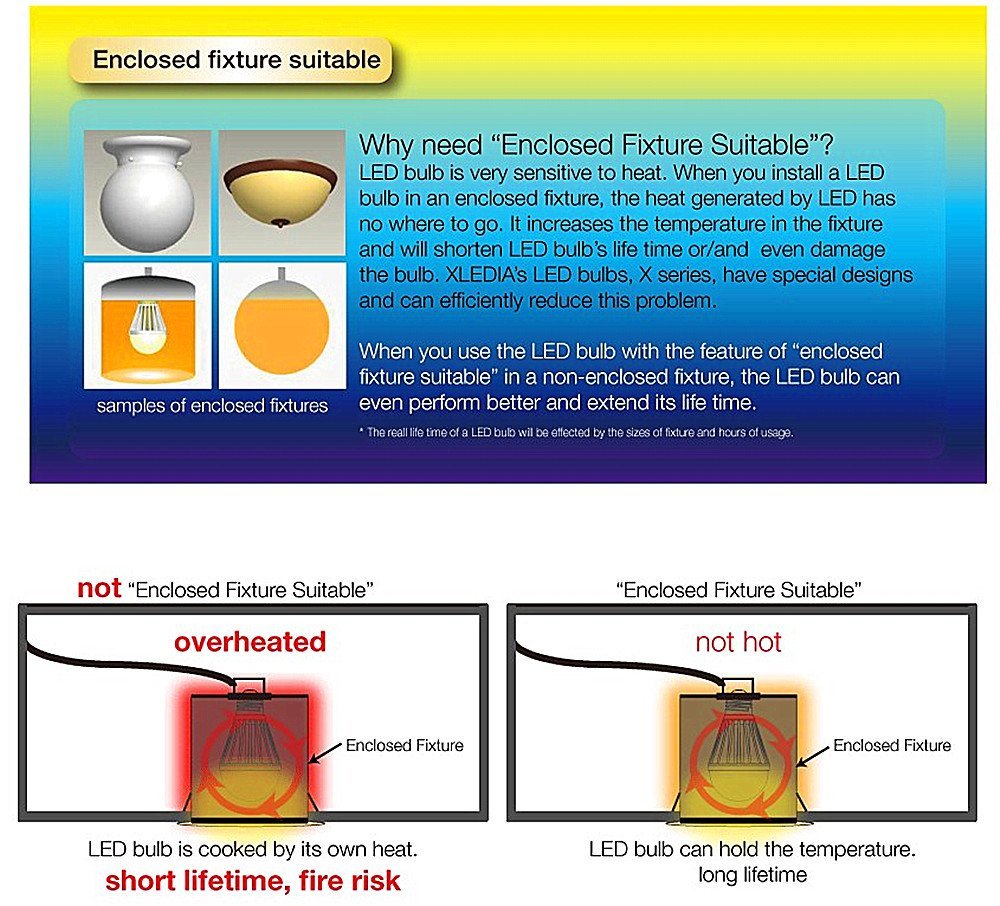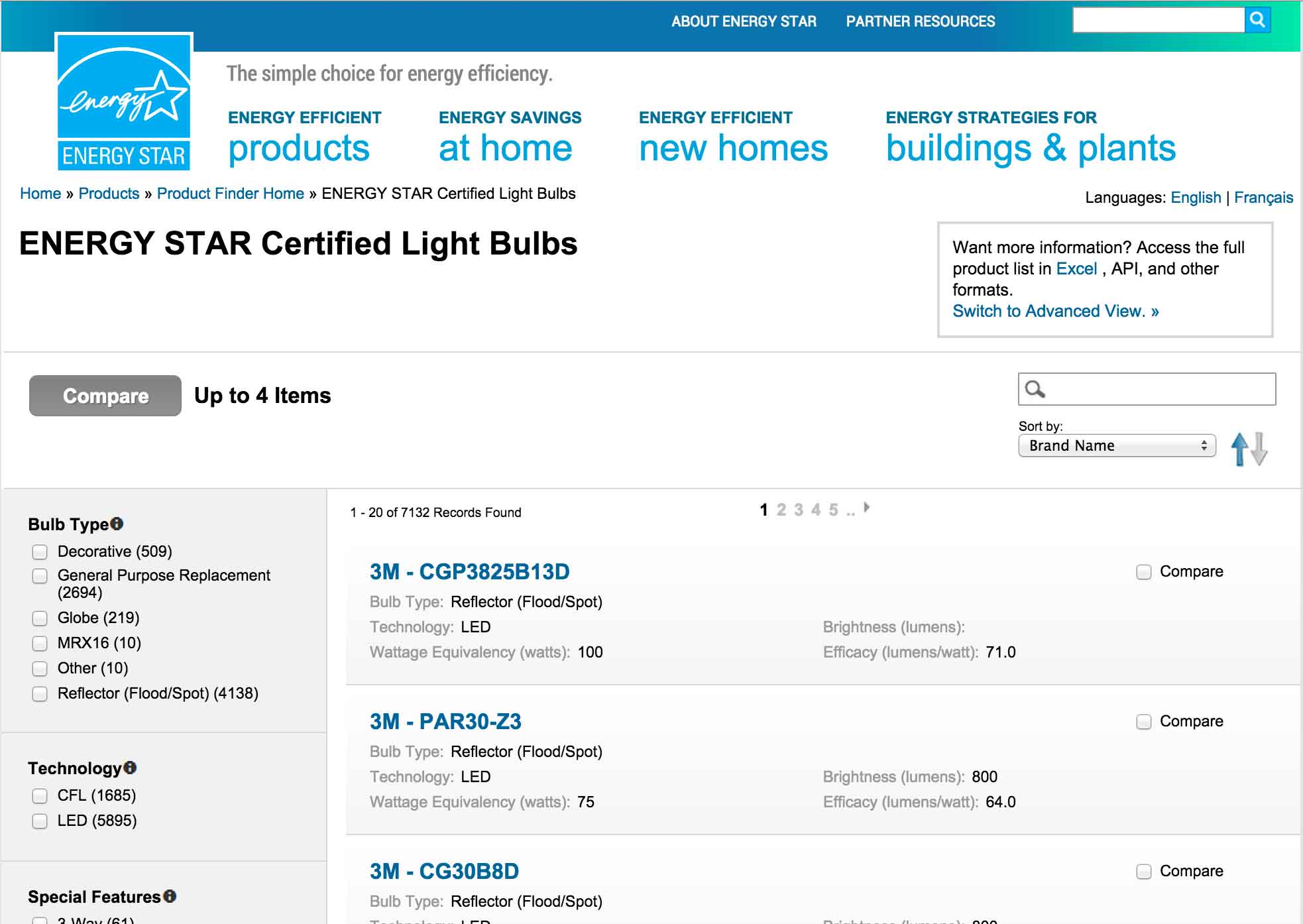
I’ve recently been helping my parents embrace the joy of replacing their beloved incandescent bulbs with LED equivalents. My biggest ally in this campaign has been the summer weather, as highs in the Southeastern United States have been consistently pushing above 90ºF (32ºC) for the past two months and show no signs of letting up any time soon. In an older, less well-insulated home it’s important to use every trick available to keep room temperatures low, and LEDs run so much cooler than incandescent lights that you can actually reach out and touch a lit glass LED bulb without burning your fingers. It was the “cool running” nature of the bulb combined with its color qualities that served to complete the “sale” of the idea to my folks. What’s not to love when you get the traditional lightbulb shape (known as A19 in the business) with cool handling and the right (warm) color temperature?
The glaring, mercury-tinged twisted compact fluorescent lightbulb debacle of the previous decade was a prime reason that my folks held a resistance to LED bulbs. My resistance was more about the confusion that existed within the range of products on store shelves. It was also about my need to make a mental shift when gauging a light’s output from wattage to lumens (a more logical method, admittedly). But, my folks and I started to “get” the technology and understand the reason for the higher price (longer life with lower power requirements, if you didn’t know).

Around this same time period one of their antiquated hallway light fixtures began to fail, due to nearly 50 years of being “baked” by incandescent bulbs. During the replacement of that hardware we swapped to an LED bulb and everybody was truly happy, it felt quite an accomplishment! A few days after that swap my dad noted a remark he’d read on one of the various LED lightbulb boxes, which mentioned the rating of the bulb as it related to “enclosed fixtures”. As you can see from the photograph, my parents’ hallway fixtures were entirely enclosed by a rectangular glass “globe” (which is, apparently an antique, as a replacement globe of the same variety seems entirely unavailable through normal Internet channels). In case you can’t tell from the photo, there are no vent ports in that glass globe and very little air circulation, which means that a bulb that hasn’t been rated for enclosures will likely burn out sooner than the period for which it’s been rated.

I was also concerned that the increased heat might represent a fire hazard, so I went a-googling for something that would work in this situation and this is what I’ve learned.
First off, do you remember that “Energy Star” sticker you see stuck on new home appliances? If you’re like me you peel that sticker off and toss it into the garbage because you aren’t about to try to figure out all of those calculations. It should just work, right? As it turns out there’s actually a website for Energy Star {www.energystar.gov} ratings that features a TON of data on a whole bunch of products, including the ability to specifically search through lightbulbs.

Note that you can either search the Energy Star database on their website OR you can download an Excel file (or a comma-separated values (CSV) file) with thousands of bulbs listed within and build your own search. The specific feature that I was checking against was a rating that permitted enclosed fixtures, which is listed in the “Special” column of that database. It appears that there are more bulbs rated “NOT for enclosed fixtures” than those that permit that use.
I spent quite some time sifting through the data and found an LED bulb by Green Creative that is denoted as being rated for use in “fully enclosed fixtures”. This bulb is available from Amazon.com. Of course, ordering every day household items like lightbulbs via the Internet seems ridiculous and I was happy when my dad’s ever-inquisitive eye fell upon the information printed on the base of some “Great Buy” brand LEDs that I had purchased from Walmart (Great Buy is Walmart’s house brand, if you didn’t know). The tiny lettering stated that these Great Value LED Light Bulb 8.5W bulbs are “Suitable for damp locations, suitable for use in totally enclosed luminaires, not for use with dimmers”.

I suspect that it will take us another 5 to 10 years for the current confusion in the LED marketplace to settle down, but until then there seem to be a lot of independent companies that are competing for consumer dollars and that the industry as a whole is still refining its message to consumers. I believe that this “enclosed fixture” issue should be represented more clearly on all packaging and hope that there are no mishaps for consumers (other than prematurely-dead bulbs).
Hope that this helps somebody!
Thankyou, very helpful as just bought a house with several old fashioned fully enclosed lights and discovered the same small writing on the led light globe box when got it home.
This was a very helpful note and I thank you. I was just advised of this problem by our cleaning lady. I didn’t know if I should take it seriously or not. Thank you for the information!
Not sure what all the fuss is about because the old filament bulbs most of us have used forever created a lot of heat and we all used them in enclosed fixtures. These LED bulbs (A19) run quite cool in comparison, have the warning but it’s just the manufacturer covering themselves from loss of bulb life.
Incandescent lights run extremely hot anyway so the extra heat generated by enclosing the bulb doesn’t add much heat proportionally. LED bulbs run much cooler but the circuitry is more sensitive to the extra heat generated so can be adversely affected.
However, with IKEA 400lm bulbs going for about $1, even if the life of the life was reduced to half, you’re still getting a good price to running cost trade off.
NO! The amount of heat that will cause a problem with an LED may be much less than created with an incandescent bulb.
I believe my bulbs have not lasted as long, in enclosed fixtures when rated “not suitable for enclosed fixtures”. Plus, in a kitchen lamp with this sort of warning, the whole lamp quit working, attached to a fan, that still works. Those are just my experiences. Now I am not willing to risk it again. What if this were to start a fire? At the least one may need to replace whole fixtures, and bulbs more frequently if not careful.
I have a dimmable LED bulb in my Tiffany style chandelier and noticed dirty water inside the schoolhouse glass enclosure. A repairman was baffled about the water with no ceiling leak. Was it the bulb that says ” not for totally enclosed luminaires?” What bulb should I use?
Oh golly, you’ve got me stumped but I suspect that you’re facing more than a haunted lightbulb issue.
Wish I had known this beforehand. Almost all lights in houses these days are in enclosed fixtures. Now I have 10 bulbs going in the trash can. What a waste. Why even sell these bulbs in the first place.
Why would you trash them
I have had two of these 13w bulbs catch fire and if I was not home who knows what would have happened, likely a house fire. Both were in enclosures
I will be replacing them soon. Incandescent burn out but leds smoke and then burn. The smell is awful and stays for weeks
I believe that most LEDs produce so little or no heat that there shouldn’t be any problem. EXCEPT, They are 12V bulbs twinned with a transformer, and that baby does heat up. So practically speaking, and exactly as you say, there is a problem. We are entering a world were most of our electronics other than heater appliances from irons to ovens, are more likely 12 or even 5 volts. If you look on amazon, or ebay, you can find tons of bulbs that do not have a transformer, and you can find separate transformers, and they don’t cost any more, or in fact less than regular LEDs. That said without ripping one’s house apart it may not be possible to get 12v to the fixture.
An example of a more efficient set-up are those lamps that were popular in the 90s that consisted of two wires that were bare and exposed, and that went from one side of a room to the other. Little fixtures were clamped to the wires, and they were all lit by one transformer. The set-ups looked primitive and dangerous due to the exposed wire, but the voltage and current were both low. These fixtures created large reductions in energy consumed as the transformers are most of the energy drain, if you have one serving multiple lights, all the better. I suppose a more common example these days are LED track Lights that operate off one transformer with as many lights as you wish to stack on them
Even if LEDs are 8 to 10 times as efficient as incandescents, they are still less than 20% efficient themselves. That means that over 80% of the energy they consume is still given off as heat from the emitters, doesn’t matter where the transformer is in that regard. True, separating the transformer from the bulbs will prolong the life of that component but the LEDs themselves are still vulnerable to heat degradation. So track lighting does not solve the problem, good bulb and fixture design does. As already mentioned, even those LED bulbs supposedly suitable for enclosed luminaires will last longer in those that are open or vented.
Enclosed fixtures can often be converted to open or venting ones by drilling holes through the sheet metal canopy and/or switching shades.
I just experienced an LED bulb failure (Noma 052-7055-4, A19 from Canadian Tire) . that could have been So much worse! I noticed a flickering upstairs and went to investigate immediately. I have a ceiling surface mounted dome fixture and was using two 10 watt LED bulbs in it. One bulb was hot to touch at the base and gave off a bad odor.
Now upon closer review of the box Caution Notice: “This device shall not be used in a totally enclosed recessed/sealed fixture”. Unfortunately this caution could be interpreted as one or three different warnings/disclaimers. Fortunately – I WAS HOME TO CATCH IT!
I purchased A 19 noma bulbs from Canadian Tire , put them in an open type kitchen lamp and within 2 months 3 of them failed . They began to blink, and the blinking kept getting faster until the bulb failed . Approximately one minute . I would say that these bulbs have approximately 500 hours on them.
I appreciate the link to the searchable bulbs. I was searching for bulb that could be used in fixtures, as were you. Unfortunately, the filter on the left does not work as it should. Selecting “Recessed Fixtures” yields results that contain hundreds of “not for use in recessed fixtures”. I suppose one could download an Excel compatible format and sift them yourself. Thanks for the suggestion
The typical bulbs these days use the casing and an internal MCPCB (metal core PCB) to spread and dissipate the heat.
I did wonder if manufacturers should be using >125C capacitors as the LEDs put out a lot of heat, and be far more vigilant with product testing especially at high temperatures.
A thermal cutout does not cost much!
Thank you so much for this information! You saved me a lot of time. I went directly to Google to find bulbs in the needed size “suitable for totally enclosed fixtures”. Thanks for sharing your research and your time.
I don’t believe you answered ther question as to whether they pose a fire hazard or not. Did you find an answer to this?
I had an LED bulb in an enclosed fixture in my bathroom and I happened to notice water in it! Is that from moisture in the bathroom? Think I’ll go back to some old bulbs I still have.